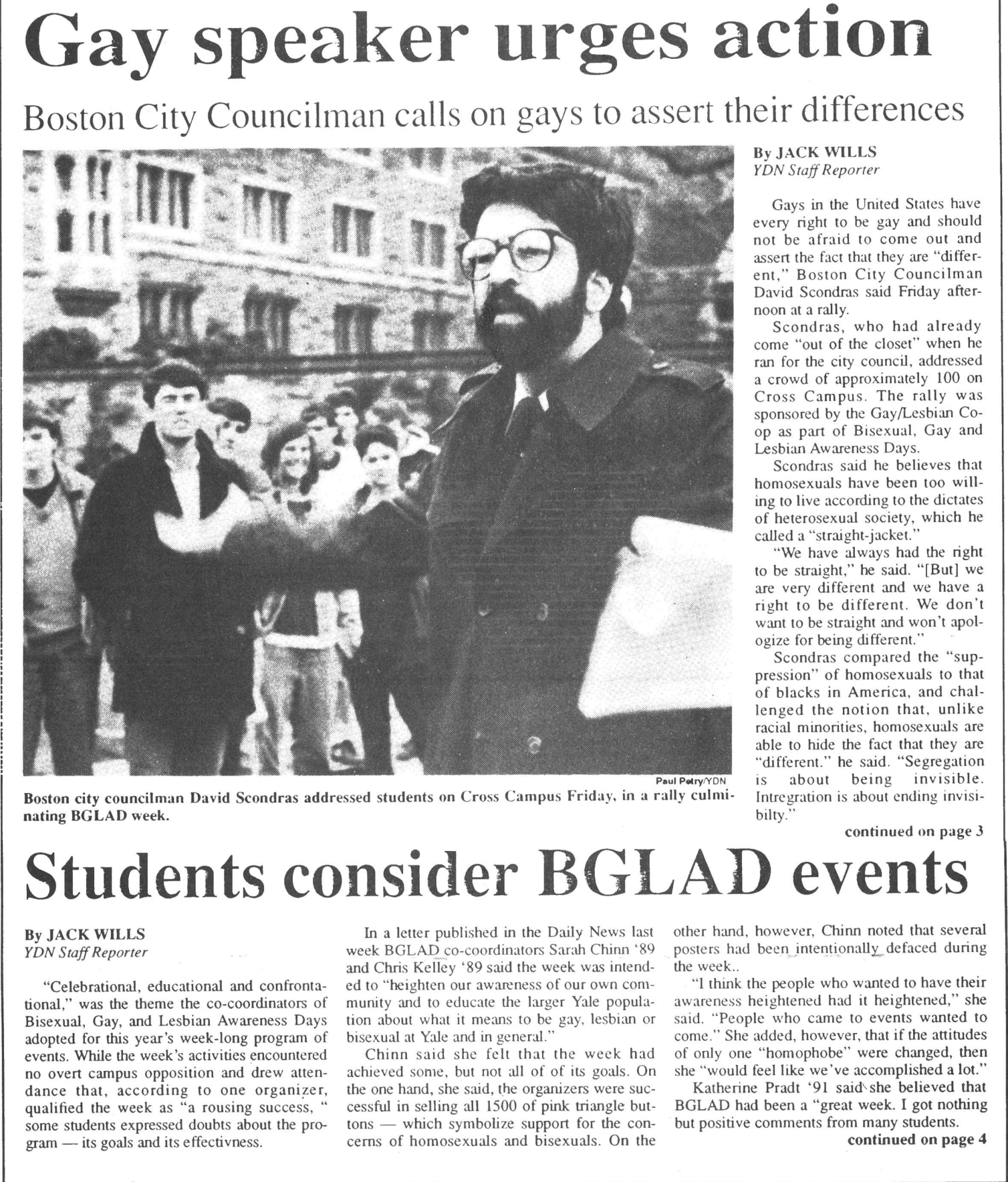Intolerance in a “garden of tolerance”
In the 1980s, the News encountered a paradox of tolerance in its stated aim of objective reporting.

In recent years, social and conventional media platforms have grappled with the free-speech dilemma. Should social media platforms be responsible for regulating speech that promotes hatred, violence or false information? How can news outlets maintain objectivity without giving undue attention to the activities and rhetoric of political extremists? While these questions may seem to be a unique malaise of the 21st century, this is far from the truth. In the 1980s, even a college newspaper like the Yale Daily News was grappling with these issues. Critically evaluating how the YDN reported on contentious events in the 1980s can offer clarity and insight on what to avoid and what to carry forward when reporting on sensitive topics today.
The Yale Daily News sparked controversy with its coverage of Bisexual, Gay, Lesbian Awareness Days (BGLAD), which occurred in late April 1988. The initial YDN article was written on April 18, 1988 and titled “Students Consider BGLAD Events.” The article featured a brief summary of the week-long program’s goals and events and then reported on a variety of student reactions to it, ranging from overwhelmingly positive to cautiously optimistic to flat-out dismissive. The reporter interviewed a number of people: the event coordinators, students who participated in or heard about the event, a student vehemently opposed to homosexuality, and a Catholic chaplain. In this attempt to objectively portray all sides of the issue, this article prompted an outraged letter to the YDN from BGLAD coordinators Sarah Chinn ’89 and Chris Kelley ‘89. On April 26, 1988, Chinn and Kelley wrote to the YDN editors, accusing them of using the facade of “good journalism” and “the name of objectivity” to cover their “editorial bias towards homophobia.” Chinn and Kelley charged that equally weighing the opinions of a representative of the Catholic Church and Wayne Dick, “the campus’ most celebrated homophobe,” was tantamount to interviewing the Ku Klux Klan or Neo-Nazis on their opinions towards Black History Month or Holocaust Memorial Day.
Chinn and Kelley’s accusation did not fade quietly into the night. Two letters to the editor quickly followed. The first, published on April 28, 1988 and titled “Catholicism is Not the Same as Nazism or Racism,” argued that Chinn and Kelley’s placement of the Catholic Church in the same camp as “the KKK and the neo-Nazis borders on slanderous.” While not Roman Catholic themselves, the writers of the letter argued that “many people at Yale” have a “serious philosophical conflict with homosexuality.” The fact that everyone was not supportive of homosexuality was “not the statement of racism that Chinn and Kelley intimate it to be,” and calling it so was “as absurd” as hosting a “Pork-Eating Awareness Week” and “maligning Jewish students who do not support it,” the letter’s authors charged. The letter writers concluded, “The News should be commended, not criticized, for objectively airing their viewpoint.” The second letter to the editor follows a similar track. Titled “Gay Community Should Not Condemn Church” and published on May 3, 1988, Jason Cahill ’89 argued that Chinn and Kelley’s accusation was unfounded. “The Catholic Church does not condemn homosexuality,” claimed Cahill, “it condemns sexual activity out of marriage, of any kind.” Furthermore, Cahill pointed out that “Yale is a garden of tolerance” and that just because BGLAD may not have “gotten the coverage it wanted” or that there was any “disagreement with your views” did not justify Chinn and Kelley’s accusation that the YDN was homophobic.
While it may not be Spring of 1988 anymore, many of the issues brought up by the coverage of BGLAD are still present. Objectivity oftentimes means tolerating all sides of the issue, including those viewpoints that are inherently intolerant. It raises complex questions: should objectivity in journalism only include respectable viewpoints? What should be the scope of inclusion in journalism? To properly report on BGLAD, did the YDN really need to include the opinions of a Catholic Church representative and Wayne Dick (who was later disciplined by the Executive Committee for hanging up homophobic posters)?
The answer to these questions is not simple, and perhaps there is not only one answer. But it may lie in the content that is being reported — in this case, BGLAD. If the goal of BGLAD was to simply raise awareness that bisexual, gay and lesbian students existed on campus, then the scope of the reporting should have been limited to the awareness raised by the event and did not need to include the opinion of the likes of Wayne Dick. However, if the goal of the event was to raise awareness about the bisexual, gay and lesbian students on campus and the struggles and animosity they faced due to their sexual orientation, then the YDN indeed should be commended for objectively reporting all sides of the issue. The inclusion of Wayne Dick and the Catholic Chaplain’s opinions undercuts the assumption from Jason Cahill (and likely other students as well) that “Yale is a garden of tolerance” and brings attention to the ongoing struggles that lesbian, gay and bisexual students faced at the time. Reporting intolerant and unsavory opinions should not be universally avoided nor universally embraced; it should be situationally dependent. While it is not always clear which path the News should take, reporting intolerant opinions requires that the News understand the purpose and likely impact in doing so.







